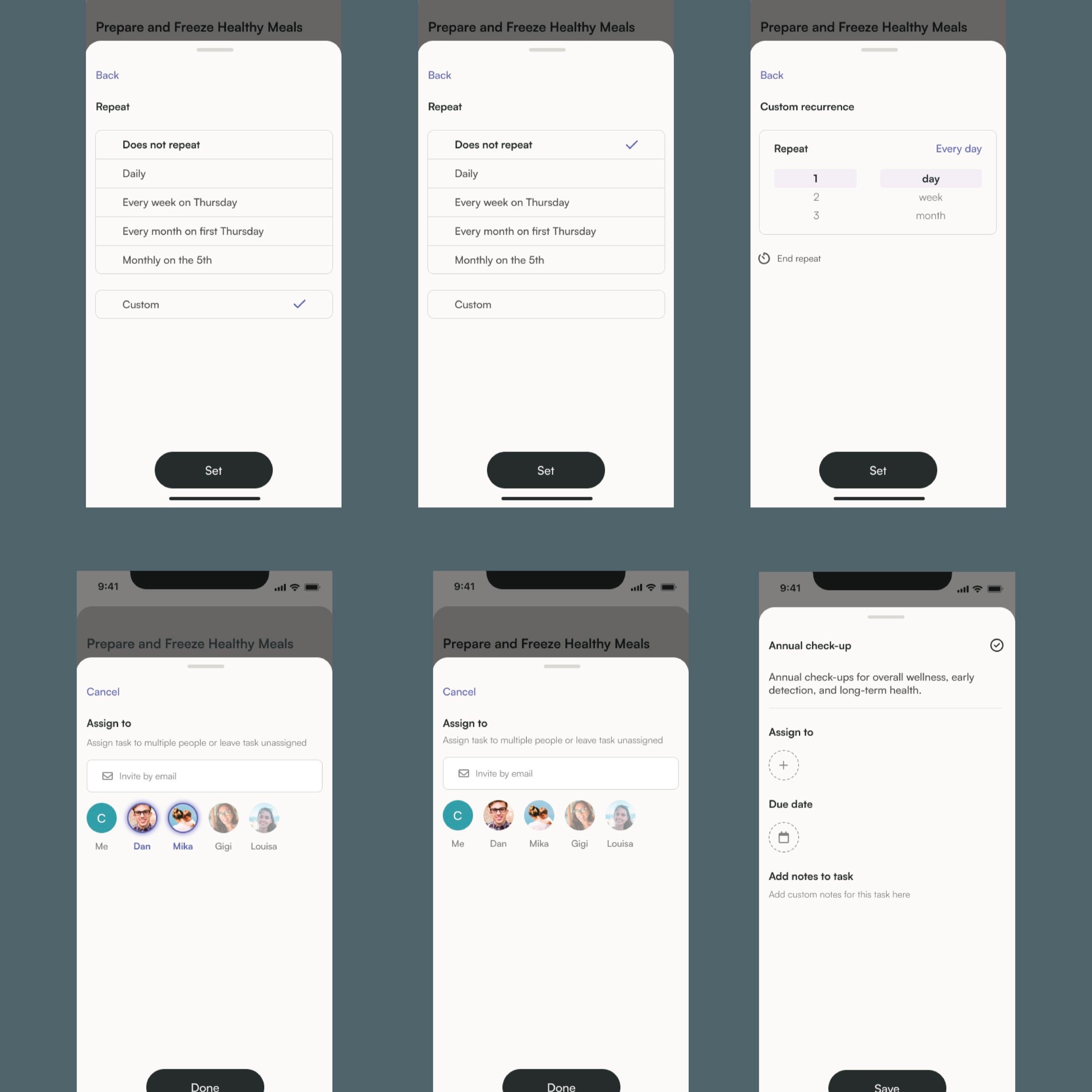
Advanced Scheduling
Overview
Improve scheduling flexibility within Mevi to accommodate diverse needs for new parents and their support networks.
Methods Used
User Flows, Wireframing, Prototyping, User Interviews, A/B testing
Tools
Figma, Slack, Notion, Google Sheets, Zoom
Timeline
Two weeks
Problem Space
At Mevi, we knew that flexible task scheduling was essential for new parents and their support networks, but we hadn’t been able to build it out in our first release. Up until this feature, users could assign tasks with fixed dates, but they lacked the ability to schedule recurring tasks or set custom deadlines. This meant parents and their helpers often struggled to coordinate responsibilities, leading to missed tasks, duplicated efforts, and unnecessary stress.
Key User Challenges
Limited Scheduling Options – Users could only assign tasks with fixed dates, restricting their ability to plan ahead or set repeating responsibilities.
Recurring & Custom Scheduling Gaps – Parents and helpers needed recurring task capabilities (e.g., “feed baby every 3 hours” or “weekly postpartum check-in”) but had no way to automate them.
Multiple Helpers, Confusing Coordination – Families, partners, and village members struggled to align schedules, often leading to duplicated efforts or unassigned tasks.
Lack of Clarity on Responsibilities – With multiple people involved, there was no clear way to differentiate who was responsible for what, when, and how often.
Without a robust scheduling system, users found themselves resorting to external tools (calendars, spreadsheets, group chats) to manage their support network—creating fragmented workflows and inefficiencies that Mevi needed to solve.
Challenges & Iterations
Balancing Simplicity & Functionality: Users wanted more control, but excessive customization became overwhelming. We streamlined options to keep it user-friendly.
Clarity in Assignments: Early designs confused users about who was responsible for what. We improved visual hierarchy and labeling.
Notification Overload: Adjusted notification settings to prevent overwhelming users while ensuring key reminders were received.
Solutions
Recurring Tasks: Set daily, weekly, or custom intervals for ongoing support.
Multiple Assignees with Individual Deadlines: Allow different members to have separate due dates for a single task.
Adaptive Reminders & Scheduling – Learns from user behavior to offer timely task suggestions and proactive reminders.
Key Design Decisions
Color-coded Assignments: Visual differentiation between one-time, recurring, and multi-assignee tasks.
Flexible Editing: Users can adjust due dates and responsibilities without disrupting task history.
Smart Defaults & Suggestions – Pre-filled scheduling options based on common postpartum timelines to reduce user effort.
Clear Task Ownership – Improved visual hierarchy and labeling to make it easy to see who is responsible for each task and when it’s due.
Case Study: Design Process & Impact
Research & User Insights
Conducted user interviews with families and their support communities.
Discovered that 70% of users preferred scheduling ahead rather than reacting to needs in real time.
Identified that caregivers and partners often needed task reminders to stay on track.
Wireframing & Prototyping
Sketched multiple layout options to simplify scheduling.
Created high-fidelity prototypes and tested different interactions.
Iterated based on feedback from usability tests.
Delivery
These enhancements provided users with a more organized, flexible, and stress-free way to coordinate family support, significantly improving engagement and task completion rates.
Assigning Multiple People to a Task
Managing postpartum support often involves multiple helpers, but Mevi’s initial system only allowed a single assignee per task. To improve collaboration, we introduced multi-assignee task management, allowing different users to be assigned to the same task with individual deadlines and responsibilities.
Flexible Scheduling
Flexible scheduling allows each assignee to have a personalized due date while offering the option for a shared deadline. The clear visual hierarchy helps users differentiate assignments, while smart scheduling options streamline coordination.
Custom Repeat
The Custom Repeat feature allows users to set tasks to repeat on a schedule that fits their specific needs. Instead of fixed intervals, users can choose to repeat tasks every X days, weeks, or months, providing more control over recurring responsibilities.
End Repeat
The End Repeat feature allows users to control how long a recurring task should continue, ensuring it fits their specific needs. Users can choose to let a task repeat indefinitely, set an end date, or limit it to a specific number of occurrences. This flexibility prevents unnecessary repetitions while keeping schedules organized and adaptable.
Final Implementation & Results
User Adoption: 85% of beta testers reported feeling more organized with the new scheduling system.
Improved User Confidence: 90% of surveyed users felt the new scheduling system made it easier to delegate and manage support.
Positive Feedback: Users appreciated the flexibility and clarity in managing support tasks.
Reflection & Next Steps
What Worked Well: The scheduling flexibility made the app more valuable to users.
What Could Be Improved: Further personalization for reminders and integrations with external calendars.
Future Roadmap: Exploring AI-driven task recommendations based on user behavior.








